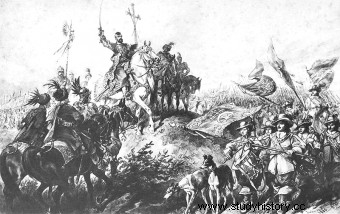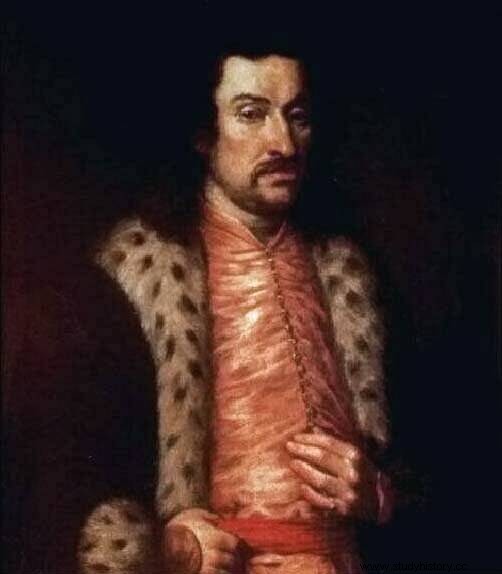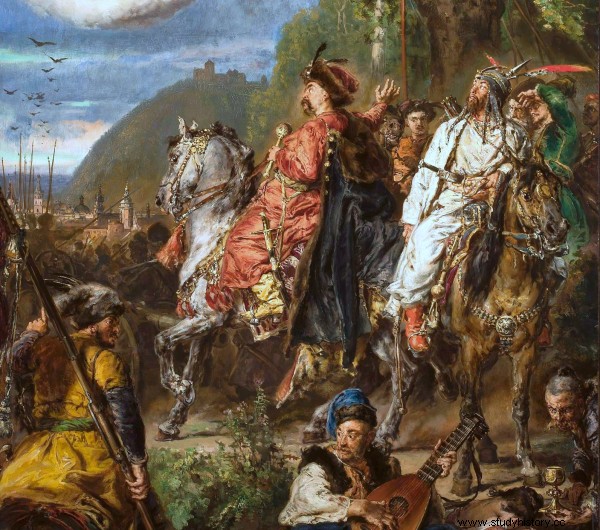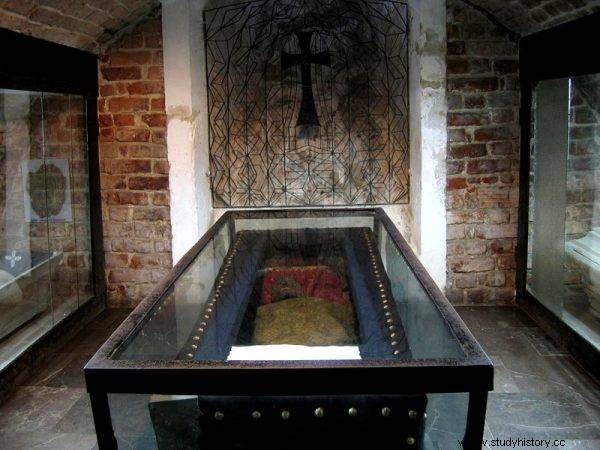He was famous for his uncompromising attitude, talent for war and cruelty. Prince Wiśniowiecki bloodily suppressed the Cossack rebellion in Ukraine. He had no mercy for his enemies, nor did he respect the ceasefire. Those who fell into the hands of the bloody magnate faced a terrible fate. At the same time, the same man saved hundreds of families from torture and death at the hands of the Cossacks. Thanks to the care of his army, civilians from Zadnieper managed to avoid unimaginable suffering.
The Wiśniowiecki family came from Lithuania, descended from Gediminas himself. Jeremi Michał Wiśniowiecki of the Korybut coat of arms was born on August 17, 1612 in Łubnie, in the Ukraine of Zadnieprzańska. Prince Jeremy's father had enormous fortune, but also prone to extravagance. He was drowning in debt, and he tried to make up for financial problems by invading his neighbors. For this he was sentenced to banishment several times.
It was probably his father who inherited the impetuosity that characterized him all his life. He entered adulthood with a chilling family history . His father was poisoned. In 1616, the Moldavian pop (Michał Wiśniowiecki engaged in military intervention in Moldova to appoint Alexander Mohyla, who was favorable to Poles) gave him a poisoned Eucharist. The murderer was sentenced to a terrible death - he was burned alive.

Prince Wiśniowiecki at the head of his army.
Three years later, the prince's mother died, and he himself came under the care of a distant relative, Konstanty Wiśniowiecki, who raised the child in the Polish and Catholic tradition. Young Wiśniowiecki was educated at a Jesuit college, and after reaching adulthood he officially converted to Catholicism, even though his mother strictly forbade him to do so.
He collected military skills in the Netherlands. While traveling abroad, he watched the siege of Maastricht. In the Polish-Lithuanian Commonwealth, Jeremi took part in the war with Moscow and led ramps behind the enemy's rear in the depths of the Moscow State, and suppressed Pawluk's Cossack Uprisings. He proved to be a great soldier, commander and strategist. He became famous, among others in the battle against the Tatars at Ochmatów in 1644. Two years later he became the Ruthenian voivode. Even then, he was applying for the queen's mace. He didn't get it for the rest of his life.
Prince Jeremi Wiśniowiecki
Wiśniowiecki inherited a gigantic estate in Volhynia and Zadnieprz. He turned out to be a good host. During his time, the neglected Dnieper was quickly populated. The rule of Prince Jeremy Wiśniowiecki provided protection and protection against devastating Tatar invasions. Jerema donated for church goods and the Orthodox church, as well as for the location of new cities and education.
Just before the outbreak of the Ukrainian rebellion, he acquired more lands around the Dnieper porohy, behind which the Zaporizhia Sich was located. Who knows, maybe if Wiśniowiecki had time to lead an effective colonization, the Chmielnik uprising would not have happened at all.

Alleged portrait of Wiśniowiecki
In the pre-harvest period of the Cossack Uprising the property of Prince Wiśniowiecki comprised as many as 38,000 farms with 230,000 inhabitants. peasants . The annual income of the prince is estimated at 600,000. then zlotys. For comparison - the budget of the entire Republic of Poland was PLN 12 million, so one Wiśniowiecki alone obtained an income of 5%. this sum. Jarema had his own army, the number of which could reach up to 6,000 soldiers - it included Hussar, Tatar, Cossack and Wallachian banners, as well as trained peasants.
Ukraine in blood
In 1648, an uprising devastating the Commonwealth broke out, which significantly contributed to the final collapse of the state. Prince Wiśniowiecki had a specific reason to engage in suppressing the rebellion. It hooked on his ground. From the beginning, he was an opponent of any deals with the rebels. In June 1648 he wrote to the voivode of Kiev, Adam Kisiel:
To (...) with them [Kozakami] the treaty was supposed to be pacified by the Republic, I do not see any foundation in this (...). If, then, the Republic of Poland would cover such excessive wounds from these traitors (...) with a hard sleep - he cannot promise himself anything else, only final fall and doom.
The situation became dramatic after the defeat of the Crown at Korsuń. The Commonwealth lost several thousand soldiers in the battle from the best type of troops - quartered. Hetmans Mikołaj Potocki and field Marcin Kalinowski were taken captive by the Cossacks. The popularity of the Chmielnik uprising grew. Thousands of volunteers from the blackness flowing into Chmielnicki joined the insurgents.
Then Wiśniowiecki - in the face of a significant advantage in numbers of the enemy - led his private army out of Zadnieper. He also took the residents with him. Thanks to him, masses of civilians survived, mainly the nobility with their families and local Jews. The Jewish chronicler Natan Hannower described the prince as a great defender of the people:
carried them [refugees] , as on eagles' wings, until he led them where they wanted. When they were in danger from behind, he ordered them to go ahead, and when they were in danger from the front, he marched ahead of them as a shield and buckler, and they camped behind him.
After the actual break-up of the Polish army, King Władysław IV died. Chmielnicki, realizing that he was weakened by the departure of the Tatars with Jasyr, could play against time and simulate a willingness to make a deal. On the Polish side, a strong “peace” party responded positively. Chancellor Ossoliński, sincerely and mutually hating Prince Jeremy, entrusted the talks to voivode Adam Kisiel. When choosing regimuments for the newly formed army, he omitted great commanders:Stanisław Rewera Potocki, Janusz Radziwiłł, Stanisław Lubomirski, and finally an obvious commander, seasoned and having his own army - that is Wiśniowiecki.
Instead of these names, the famous "quilt", "Latin" and "baby" won , that is in the following order:Dominik Zasławski, called by Chmielnicki (apparently he invented these nicknames) "eiderdown" due to his love of laziness, comforts and bodily pleasures, Mikołaj Ostroróg, defined as "Latin" due to his tendency to talk and discuss, and Aleksander Koniecpolski, being a "child" by his young age and inexperience (he was 28 at the time).

Bohdan Chmielnicki and Tugai Bey near Lviv
Accurate "summary" of regimojny was unfortunately confirmed in the disgraceful battle of Piławce where, terrified by the rumors that the Tatars were joining the Cossacks, they fled, leaving everything in the military camp. There was also Jarema with his army. As prince Jan Widacki claimed in his biography:"Wiśniowiecki is left, who will try to contain the panic by invoking the escaped people to refrain from escaping and to gather with him" .
Wiśniowiecki did not accept the arrangements (he represented the nobility who had lost their property in the Cossack rebellion). Perhaps he just saw that the talks had not stopped the wave of violence. On his own, he waged a guerrilla war and guerrilla warfare. More than a month before the defeat of the Crown troops at Piławce on July 28, 1648, commanding his own army in the Battle of Konstantynów, he crashed the many times stronger Cossack unit of Maksym Krzywonos.
Wiśniowiecki impeller
He dealt cruelly with the captured. Typical tortures used by the people of the Ruthenian voivode were impalement and shearing. The first of the torment was practiced since antiquity, known and used, among others by the Hittites, and in modern times "popular" and spread in areas invaded by the Ottoman Empire - incl. in the Balkans, but also in the south-eastern part of Poland.
A sharpened finger pulled by horses stuck into the anus or perineum of the condemned man. However, immediate death was not sought. Then the pile was placed vertically. The blade, under the weight of the victim, pierced other organs . A man loaded crookedly went through much more painful torture. The torment could last for several days. 80 years after the Chmielnicki uprising, a description of the piling of haidamaks in Ukraine was left to us by the chronicler Jędrzej Kitowicz:
Polish commanders, many got haidamaks alive, they did not pardon any of them, but they were hanged on branches right on the square, or if they had time, they were impaled alive; which execution followed this method:the naked haidamaka was placed on the stomach on the ground; a master or a peasant capable of execution used to cut him with a rump hatchet, sharply put a rubbed pole from one end into the pit where the manure comes out of a man, put a pair of oxen in a yoke to his feet and slowly pulled the haidamaka on the stake, chasing him to go straight.
Having planted the haidamak on a stake, and sometimes two on one, when there were many people to be executed and few piles, they lifted the stake up and buried it in the ground. If the stake went straight out with the head or neck, the haidamak died quickly; but if he went out with his arm or side, he lived on a stake until the third day (...).

One of the favorite tortures used by the people of Jeremy Wiśniowiecki was stringing on the stake.
But was the "terrible prince" a sadist who liked suffering and inflicted it without justification? Or maybe it is closer to the truth that he adapted his methods to the actions of the opponent? From the beginning of the outbreak of the rebellion, the Cossacks were characterized by extreme cruelty. Orthodox civilians were the most frequently victims of slaughter and torture.
Some of them had their skin torn off and their bodies thrown to the dogs for food, others had their arms and legs cut off, and their torso thrown onto the road […]. Children were slaughtered in their mothers' wombs; many children were cut to pieces like fish . […] And they hung babies on their mothers' breasts, other children were put on a spit and so roasted on a fire and brought to their mothers to eat their meat […]. They did all of this, wherever they went, they did the same with Poles, and especially with priests.
Does the above description of the Jewish chronicler Hannover not justify the severity of punishments applied by Prince Jeremy? Crimes during the uprising were commonplace. In his first universal from the beginning of 1648, Chmielnicki himself appealed to the Cossacks:"Thus, kill your lords and their servants, the Jews, cut down, destroy our land for purity, which we promise to be blessed" .
At Batah, the Cossacks and Tatars carried out a mass execution of soldiers of the Crown troops. Several thousand soldiers were murdered. In Pohrebyszczach, Maksym Krzywonos impaled Jews and Poles. In response, Wiśniowiecki ordered the hands to be cut off and the pops and townspeople collaborating with the rebels to be piled on stakes.
Nota bene, this town cruelly tasted the bitterness of war. A few years later, Stefan Czarniecki invaded them with his troops, taking bloody vengeance for the murder at Batoh (his brother was also among those killed). The aforementioned Pohrebyszcze were no exception in the war career of Czarniecki.
His people were "famous" for pacification, robberies and crimes. Wherever they appeared, they left ashes behind them - this was the case not only in Ukraine, but also in Greater Poland, Pomerania or even Denmark. Czarniecki himself had a special need of revenge against the Cossacks. More than once, including just before his death, he set off on bloody pacifications. What's interesting - today he is not remembered for it, but he is treated as a national hero, and his name is mentioned in the anthem - unlike Wiśniowiecki, who is considered a cruel man.
Is it right? It seems not. The fame of the "terrible prince" is largely pop-cultural today. Meanwhile, Prince Wiśniowiecki was a child of his times. The Cossacks were afraid of him, because as a borderland magnate, a local man, he was able to "get away". Perhaps it was realized that the Ruthenian voivode could act quickly, he had a selected private army and would not hesitate to use it.
As scary as it sounds, he didn't do anything "extraordinary" by the standards of the 17th century. Whether the tat for tit measures were actually justified from the perspective of the campaign itself, or not a different policy should be adopted - this can be discussed, but always when assessing the historical figure, one should take into account the realities of the epoch, and these were cruel.
The prince who severely punished the rebels with the proverbial "fire and sword" turned out to be the savior of thousands of refugees from Cossack-Tatar murders. It was they who owed Jarema the preservation of life. It was under the supervision of the voivode's army that they embarked on a long six-week march to the west, through marshes and forests, to Chernihiv and Polesie. Otherwise, they would face torture and death in torment. Under the care of the army of the voivode, among others 500 Jewish families. As we know from the chronicles, the prince adjusted the pace of the march to the civilians. He made stops when necessary and made sure that people were not left behind.
Wiśniowiecki was also the savior of the Republic of Poland. It was he kept his head and de facto managed the defense of Zbaraż , besieged by forces estimated at 200-300 thousand people - around 70 thousand. Cossacks, 40 thousand Tatars and a large number of peasants who joined the rebellion. The fortress was defended by a maximum of about 15 to 20 thousand. people, of which the Crown troops alone were 9,000.
The prince, as the commander of the Crown Forces, gave a personal proof of his bravery. He stood up for defense together with the army. Anyway, he was wounded during the fights. Apparently, when the negotiations began, the Tatars persuaded the Poles to go to their camp for talks by Wiśniowiecki himself. The defenders, however, received information that Jarema would not have come out of these negotiations alive. When Poles were starving outside the walls, Wiśniowiecki personally talked to the soldiers, encouraged and motivated them. The military was spreading a false rumor that the king was already approaching to help. Chronicler Kasper Niesiecki recalled:
A brawny siege, like a big heart, like a fearless advantage, a wise industry withstood [Wiśniowiecki] , it is difficult to say, he was the first to punch, as he was shot in the leg with a bullet there, the last one left the field:there was only one doubt, where he worked more, whether day and night, chasing such a numerous enemy or the Polish cavalry (chivalry) in this siege to stay, unpaid for a long time, soothing; it is certain that with seriousness, already with various gifts, after all, he effectively convinced them that they defended themselves with uninterrupted courage until the very end.

The tomb crypt of the Oleśnicki chapel - this is where the alleged body of Prince Jeremy Wiśniowiecki is to be located
Finally, Wiśniowiecki contributed to a wonderful victory at Beresteczek. At the crisis moment of the battle, when the Poles ventured too far into the Tatar ranks and were threatened with a counterattack, Wiśniowiecki stopped and then defeated the enemy with a great charge from the left wing, contributing to one of the greatest victories in the history of Poland (also in one of the greatest battles in the 17th century). After this victory, Chmielnicki had to flee the battlefield. He found himself in a deplorable situation because the Tatars did not want to stay with him anymore.
Unfortunately just a month after Beresteczek, at the age of 39, the prince died in a military camp on August 20, 1651, To this day, it is not clear what caused his death. Suddenly he got diarrhea and a fever. Perhaps it was food poisoning, or maybe poison? And such "conspiracy" hypotheses appeared immediately after his death. Even an autopsy was performed to verify it, but neither confirmed nor denied the alleged murder. The death of the prince certainly stopped the development of events, which was positive for the Lachs. Allegedly, upon hearing about this, Chmielnicki was supposed to shout:"Here, heaven has heard our prayers!".
So does "the hammer of the Cossacks" deserve only a black legend and the omission of the white one? Of course not. His gloomy fame was built to be exaggerated. Today, it is debatable whether he was right when he used the method of retaliation, but he cannot be denied the determination and consistency that the decision-makers in the Crown lacked at the crisis moment - not only on the battlefield, but also in the policy towards the borderlands. The notorious atrocities of Jeremy Wiśniowiecki cannot be considered without context. Finally, one must not forget how the princes were perceived by their contemporaries. And for them he was a great leader and a hero.
On August 22, 1651, the army gave the commander of the crown forces a wonderful funeral. “The body was led through the camp between two ranks of regiments. The priests led the way, and behind the body stretched the long tail of an army for almost a quarter of a mile. The coffin was transported in a scarlet velvet covered carriage with the dead man's gear . The mounted troops stood in two rows. There was an infantry in the procession, and a regiment of guards near the carriage, all with their arms down. Two lancers walked in front of the body, and five Cossack banners of the deceased behind the body. The ensign of Podolia carried a stamp lowered to the ground. The drums were beaten, and as a sign of mourning, surmas and trumpets sounded, ”Wojciech Miaskowski, the chamberlain of Lviv, described to the king. Wiśniowiecki was buried in the Holy Cross sanctuary in the Świętokrzyskie Mountains.
Albrecht Radziwiłł, the chancellor of the Grand Duchy of Lithuania, said of the deceased:"A small stature, but the highest equal with virtue, courage and dignity." The figure of Prince Jeremy Wiśniowiecki was immortalized in the novel "With Fire and Sword" by Henryk Sienkiewicz.
Read also:We will destroy your childhood. It's time to check how much truth is in Sienkiewicz's "Deluge"
Bibliography:
- Iwona M. Dacka: The Polish Crown of Kasper Niesiecki:a monument to old Polish heraldic literature , Warsaw 2004.
- Janusz Kaczmarczyk: Bohdan Chmielnicki . National Institute Ossoliński 1988.
- Jędrzej Kitowicz: Description of customs during the reign of Augustus III, Poznań 1840.
- Julian Ursyn Niemcewicz: Collection of historical diaries about old Poland from manuscripts, and also works in different languages about Poland, and with original letters of kings and eminent people in our country. Vol. 4 , Warsaw 1822.
- Władysław Tomkiewicz: Jeremi Wiśniowiecki 1612–1651 . Warsaw 1933.
- Jan Widacki: Prince Jarema , Katowice:"Śląsk" Publishing House 1988.
- Romuald Romański: Prince Jeremi Wiśniowiecki , Warsaw:Bellona 2009.
- Zbigniew Wójcik: Cossack wars in old Poland . Krakow:National Publishing Agency 1989.
- https://ciekawostkihistoryczne.pl/leksykon/jeremi-wisniowiecki-1612-1651/
